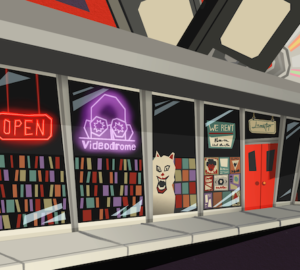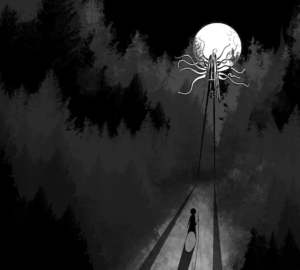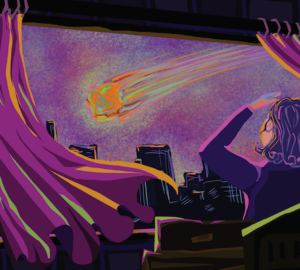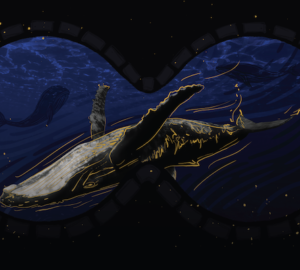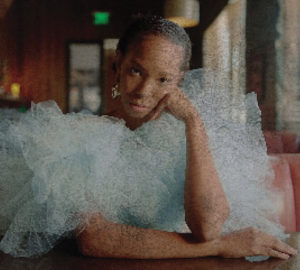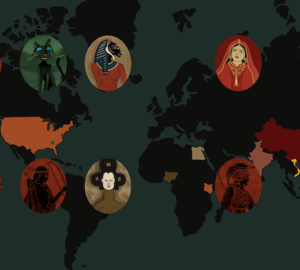WRITTEN BY TYLER SPINOSA | ILLUSTRATED BY HELEN CHOI

In the past, stories broke conventions and incorporated an added level of interactivity uncommon for the time. The “Choose-your-own-adventure” childhood novels come to mind, where the reader could alter the course of the story and the ending, depending on their choices.
Traditionally, the most interactive medium was video games. Depending on the narrative and the type of game, the level of interactivity varied. These are stories where the player has the ability to drop in as the protagonist and make decisions in real-time as to what happens next. But as we move into the future of entertainment, there’s a particular focus on interactivity within typically passive mediums like film, TV, books, audiobooks and radio plays.
Moving forward with new media and the expansion of what is possible with social platforms, there is a rise in the types of narratives that audiences can affect directly. This transforms lifeless mediums of the past into something closely resembling the experience of playing a video game.
Sandbox storytelling does not always appeal to a larger audience because many people prefer a one-sided experience when they consume media. However, with the help of social platforms and the internet, the future of narrative exploration is beginning, with greater degrees of interactivity.
The incorporation of the audience into narratives has already taken place across a multitude of platforms. “Bandersnatch” on Netflix, the alternate reality game “Everyman Hybrid” on YouTube and Wham City Comedy’s “The Cry of Mann” on the Adult Swim Live Streams all use varying levels of interactivity in their stories to turn the audience into characters within the stories themselves.
In the case of Black Mirror’s “Bandersnatch,” the audience is given the choice between two options at different points in the story which affects the path the main character takes. “Everyman Hybrid” was a YouTube series that had supplemental materials that spanned across multiple online platforms. Some characters had Twitter accounts and blogs — heavily inspired by the novel “House of Leaves” by Mark Z. Danielewski. This narrative also placed the viewers as characters within the story itself by giving them the ability to interact with the main characters and actively let them seek out information as the events unfolded.
Wham City Comedy’s limited series “The Cry of Mann,” and the subsequent second season, “The Call of Warr,” on Adult Swim’s live streaming platform are best described as interactive soap operas which take heavy cues from the work and mythos of author H.P.
Lovecraft. In these stories, the call-in feature of the live-stream brought the viewers into the story in a similar way to “Bandersnatch.” Except, in this case, the viewers could directly speak to the characters in real time on a live broadcast and play the role of an ethereal, otherworldly voice from the heavens.
In these examples, there is an extra level of effort and responsibility placed on the viewers, rendering them characters instead of passive observers. The ability to join in on the adventure is something that is still in its infancy, despite being developed in various ways. While “Everyman Hybrid” and “The Cry of Mann” are niche projects known to a select group of fans, Netflix’s “Bandersnatch” is an example of how this type of narrative found its way into mainstream audiences.
The future of media lies with this type of interactivity. While there will always be a market for media in which you can observe from a distance, more and more people are interested in becoming a part of the story. The advent, refinement and integration of virtual reality is a wealth of opportunity in this particular type of storytelling. In the future, viewers will be able to literally become a part of the story, placing themselves directly into the shoes of characters spanning an entire fictional universe. It won’t be limited to inhabiting the minds and bodies of heroes and villains. Instead, it will be possible to operate from the perspective of any character within a completely autonomous world that mirrors reality.
The viewers’ role in the stories they interact with and consume is becoming much more interactive. Many exciting possibilities have yet to be invented and are not fully comprehensible within the scope of our current knowledge and access to technology. Regardless, if there’s one thing we know, it’s that the future of media is drenched in interaction


